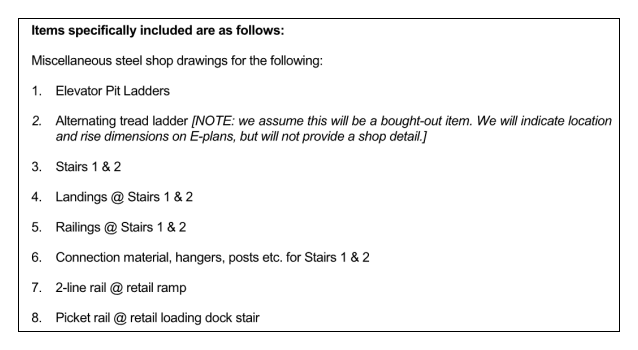Scope of work is key to any construction contract. It can be a disaster to miss a scope item at bid time which you are responsible for later. Almost as bad, is doing extra work that was not included in your or your client’s scope. So, the first step in any steel detailing project is a scope review. And especially with miscellaneous steel detailing, it’s a good idea to do this review at bid time and include a thorough and specific scope list in your proposal.
Ideally, your client will provide you with their scope list at the time of bid. Absent a client document, the only way to generate a good scope list is a thorough review of all of the contract design drawings, specifications, and addenda. This process is only complicated when the structural steel and miscellaneous metals are split between two different fabricators, or two different detailing outfits. This leads to push and pull between the parties as to which components are considered to be miscellaneous metals and which are structural steel.
The structural scope is easier to determine because structural steel is defined pretty clearly in the AISC Code of Standard Practice:
2.1. Definition of Structural Steel
Structural steel shall consist of the elements of the structural frame that are shown and sized in the structural design drawings, essential to support the design loads and described as:Anchor rods that will receive structural steel.
Base plates, if part of the structural steel frame.
Beams, including built-up beams, if made from standard structural shapes and/or plates.
Bearing plates, if part of the structural steel frame.
Bearings of steel for girders, trusses or bridges.
Bracing, if permanent.
Canopy framing, if made from standard structural shapes and/or plates.
Columns, including built-up columns, if made from standard structural shapes and/or plates.
Connection materials for framing structural steel to structural steel.…
[AISC Code of Standard Practice, section 2.1]
The list goes on from there, but it’s enough to say that the phrase, “if attached to the structural steel frame,” figures prominently in nearly every item. So, if structural steel is any steel that is integral to, or attached to the skeleton, or armature if you will, of the building, then miscellaneous steel is, well, everything else. Stairs, railings, ladders, loose lintels, and hundreds of odds and ends made out of steel. And there are often gray areas. For instance, door frames are usually considered miscellaneous, though they often do attach to the structure.
Ultimately, the only way to hash this all out is communication. Communicate with your client to understand their requirements and expectations, and provide feedback in the form of a detailed scope list at bid time. This is the best way for all parties to understand exactly what work is to be performed, and your approved proposal document will serve as a means to resolve any scope issues that may arise during the project.

